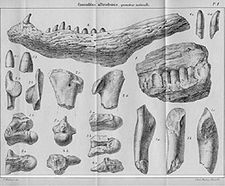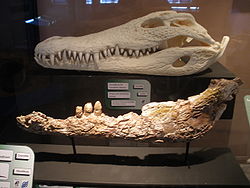- Musturzabalsuchus
-
Musturzabalsuchus
Temporal range: Late CretaceousJaw Scientific classification Kingdom: Animalia Phylum: Chordata Class: Sauropsida Order: Crocodylia Superfamily: Alligatoroidea Genus: Musturzabalsuchus
Buscalioni et al., 1997Species - M. buffetauti Buscalioni et al., 1997 (type)
Musturzabalsuchus is an extinct genus of crocodylian, and one of the oldest known members of the superfamily Alligatoroidea. The generic name means "Broadened rostrum crocodile", with "Musturzabal" meaning "broadened rostrum" in Basque and "suchus" meaning "crocodile" in Latin. The type and only species is M. buffetauti, named after the French paleoherpetologist Eric Buffetaut. The material first assigned to Musturzabalsuchus in 1997 has been found from the locality of Laño in Condado de Treviño, northern Spain.[1] Although dating back to the Late Cretaceous, the exact age of the strata in which material of Musturzabalsuchus occurs in the locality is not known: it is either Late Campanian or very Early Maastrichtian.[2] Despite the unusually high quantity of remains belonging to the genus (most other continental Late Cretaceous crocodilian genera from Europe are poorly represented), the only skeletal elements known from Musturzabalsuchus are the maxilla and mandible. Some fragments of these bones have been found from the locality of Armuña in the province of Segovia that were previously referred to an unnamed trematochampsid.[3] Like the holotype and paratype material found from Laño, these fossils, known collectively as UPUAM-502, are Campano-Maastrichtian in age.[1] Another specimen (MHNM 10834.0) from the Fuvelian Lignites of France has been referred to Musturzabalsuchus in 1999.[4] However, the characteristics used to assign the material to better known specimens of Musturzabalsuchus from Spain were questioned in a later study.[5] Material from Musturzabalsuchus has been found more recently from Valencia, Spain, being slightly older in age than specimens from other localities, dating back to the Early or Middle Campanian.[6]
Contents
Phylogenetics
 Illustration of the remains of "Crocodilus" (Massaliasuchus) affuvelensis from the Fuvelian Lignites, 1869. Mandible resembling Musturzabalsuchus illustrated at top.
Illustration of the remains of "Crocodilus" (Massaliasuchus) affuvelensis from the Fuvelian Lignites, 1869. Mandible resembling Musturzabalsuchus illustrated at top.
Musturzabalsuchus possesses several synapomorphies that place it within Alligatoroidea, including a lateral displacement of the foramen aerum of the articular. Additionally, the enlarged fourth mandibular tooth occludes into a pit in the rostrum.[7] Only the latter feature is present in the more derived alligatorids, and thus it is excluded from the family.[7] The pit that the fourth mandibular occludes into is placed posterior to the last premaxillary tooth, similar to what is seen in "Diplocynodon" hantoniensis, another early alligatoroid. A figure used in an 1869 study by P. Matheron of crocodylian remains from the Fuveau lignites (illustration) pictured a mandible similar in profile to that of Musturzabalsuchus, but was labeled as belonging to the crocodylian Crocodilus affuvelensis.[8] In 1997 it was suggested that due to this apparent similarity, along with the vagueness of descriptions in the 1869 paper and the loss of the syntype, that C. affuvelensis could be reassigned to Musturzabalsuchus, although it was also acknowledged that the lack of posterior cranial material in the genus made detailed comparisons difficult.[1] A recent 2008 study on Matheron's specimens colcuded that they belonged to a new genus distinct from Crocodylus and different from Musturzabalsuchus, named Massaliasuchus.[5]
Paleobiogeography
Musturzabalsuchus and Acynodon, a contemporary crocodilian also common from Laño, are thought to have been closely related to Paleolaurasian alligatoroids. The later genus is the only taxon not known from North America to be related to the more derived Late Cretaceous tribodont alligatorids. It is clear that Musturzabalsuchus was endemic to Europe, and was most likely restricted to Ibero-Armorica Island,[9][10] as the genus is absent from Northern and Eastern European localities from which other alligatoroid fossils have been found.[1]
References
- ^ a b c d Buscalioni, A. D.; Ortega, F.; and Vasse, D. (1997). "New crocodiles (Eusuchia: Alligatoroidea) from the Upper Cretaceous of southern Europe". Comptes Rendus de l’Académie des Sciences, Série II 325: 525–530.
- ^ Astibia, H.; Garcia-Garmillo, F.; Orue-Exteborria, X.; Rodríguez-Lázaro, J.; Buscolioni, A. D.; Sonz, J. L.; and Jiménez-Fuentes (1987). "The Cretaceous-Tertiary Boundary in a sector of the South Limb of the Miranda-Treviño Synclinal: the first appearance of Chelonia and Archosauria in the Basque Country". Cretaceous Research 8 (1): 15–27. doi:10.1016/0195-6671(87)90009-7.
- ^ Buffetaut, E. (1989). "Archosaurian reptiles with Gondwanan affinities in the Upper Cretaceous of Europa". Terra Nova 1 (1): 69–74. doi:10.1111/j.1365-3121.1989.tb00328.x.
- ^ Buscalioni, A. D.; Ortega, F.; and Vasse, D. (1999). "The upper Cretaceous crocodilian assemblage from Laño (northcentral Spain): implications in the knowledge of the finicretaceous European faunas". Estudios Museo de Ciencia Naturales de Alava 14: 213–233.
- ^ a b Martin, J. E.; and Buffetaut, E. (2008). "Crocodilus affuvelensis Matheron, 1869 from the Late Cretaceous of southern France: a reassessment". Zoological Journal of the Linnean Society 152 (3): 567–580. doi:10.1111/j.1096-3642.2007.00358.x.
- ^ Rodriguez, J. C.; Feist, M.; Peyrot, D; Barron, E; Robles, F.; Pereda-Suberbiola, J.; and Ruiz-Omenaca, J. I. (2005). "Stratigraphic position and palaeoenvironmental traits of the Late Cretaceous vertebrate-bearing sites of Chera (Valencia, Spain), based on micropalaeontological data". Kaupia 14: 76.
- ^ a b Norell, M. A.; Clark, J. M. and Hutchison, J. H. (1994). "The Late Cretaceous alligatoroid Brachychampsa montana (Crocodylia): new material and putative relationships". American Museum Novitates No. 3116: 1–26.
- ^ Matheron, P. (1869). "Note sur les reptiles fossiles des dépôts fluvio-lacustres crétacés du bassin à lignite de Fuveau.". Bulletin de la Société Géologique de France 26: 781–795.
- ^ Ibero-Armorica consisted of what is now the Iberian Peninsula and southern France
- ^ Le Loeuff, J. (1991). "The Campano-Maastrichtian Vertebrate faunas from southern Europe and their relationships with other faunas in the world: paleobiogeographical implications". Cretaceous Research 12: 93–114. doi:10.1016/S0195-6671(05)80019-9.
External links
Categories:- Prehistoric reptiles of Europe
- Cretaceous crocodylomorpha
Wikimedia Foundation. 2010.

